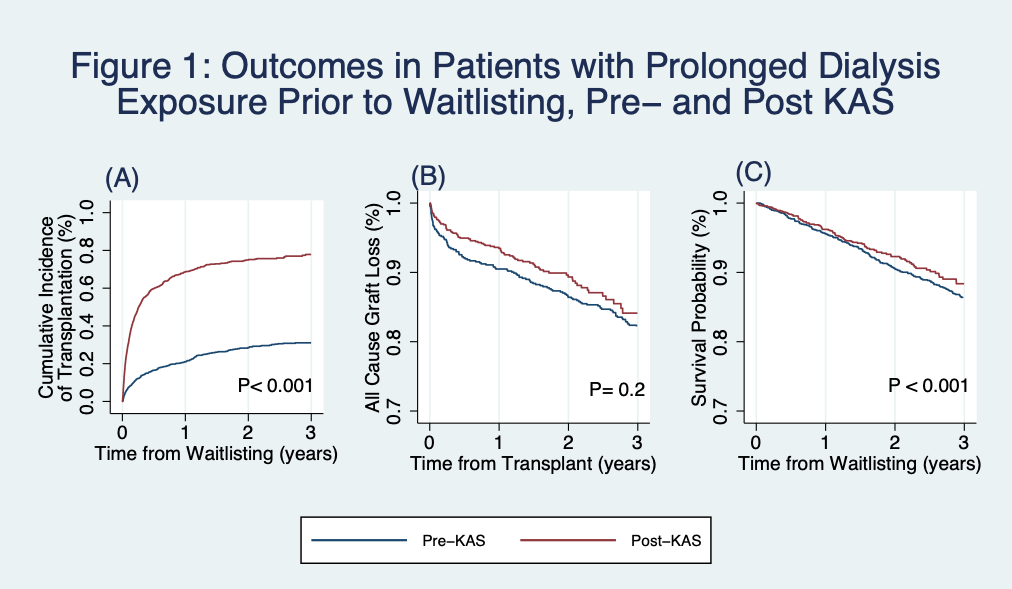Impact of the Kidney Allocation System on Kidney Transplant Outcomes in Patients with Long Dialysis Treatment (> 10 Years)
Medicine, Division of Nephrology, University of British Columbia, Vancouver, BC, Canada
Meeting: 2021 American Transplant Congress
Abstract number: 833
Keywords: Allocation, Graft function, Kidney transplantation, Waiting lists
Topic: Clinical Science » Kidney » Kidney Deceased Donor Allocation
Session Information
Session Name: Kidney Deceased Donor Allocation
Session Type: Poster Abstract
Session Date & Time: None. Available on demand.
Location: Virtual
*Purpose: Prior to the new kidney allocation system (KAS), patients treated with dialysis for > 10 years before transplantation were shown to derive a survival benefit from transplantation (Gill CJASN 2017). With the new KAS, the accrual of waiting time was back-dated to the date of first chronic dialysis for patients wait-listed after the start of chronic dialysis treatment. This led to a large increase in wait-list activations of patients with long dialysis vintage >10 years who had never been previously wait-listed. The outcomes of these patients with long dialysis vintage >10 years who were opportunistically wait-listed after the new KAS are unknown.
*Methods: The study included n = 1446 adult > 18 years patients in the 2019 USRDS data base who were wait-listed for a kidney transplantation after >10 years of dialysis treatment in a 12 month period after the implementation of the new KAS in Dec. 2014, and a control group of n=1183 patients with >10 years of dialysis treatment who were wait-listed for transplantation in the 12 months prior to implementation of the new KAS. Patient characteristics pre- and post- KAS were compared, and access to transplantation was compared with cumulative incidence curves. Outcomes including overall survival, all cause graft loss (ACGL), death censored graft loss (DCGL), and death with function (DWF) pre- and post- KAS were compared with univariable and multivariable models.
*Results: Patients with long dialysis vintage prior to waitlisting were similar pre- and post- KAS, being predominantly black (58%), Medicare insured (76%) and not highly sensitized. Those listed post-KAS had improved access to transplantation compared to those listed pre-KAS (78% vs 31% transplanted at 3 years after listing) (Fig 1A). Among patients who received a transplant (n = 686) pre and post KAS (n = 974) there was no difference allograft survival (Fig 1B). The overall unadjusted survival of waitlisted individuals was superior post-KAS compared to post KAS (Fig 1C).
*Conclusions: The new KAS has successfully improved access to transplantation for patients with prolonged dialysis treatment , with improved survival and no deterioration in transplant outcomes. Unlisted patients with long-dialysis vintage should be prioritized for transplant evaluation.
To cite this abstract in AMA style:
Kadatz M, Vaishnav S, Brar S, Chang D, Lan J, Gill J. Impact of the Kidney Allocation System on Kidney Transplant Outcomes in Patients with Long Dialysis Treatment (> 10 Years) [abstract]. Am J Transplant. 2021; 21 (suppl 3). https://atcmeetingabstracts.com/abstract/impact-of-the-kidney-allocation-system-on-kidney-transplant-outcomes-in-patients-with-long-dialysis-treatment-10-years/. Accessed December 16, 2025.« Back to 2021 American Transplant Congress

